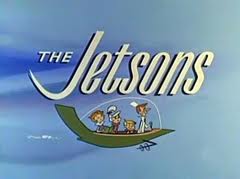Remember when the future was a wonderful thing? Well, it was in the 1960s in the world of The Jetsons.
The future was all about push buttons which could improve our lives and create new efficiency. Meals came at the push of a button. Music came at the push of a button. Cars came at the push of a button. Raincoats came at the push of a button. However, what even push buttons couldn’t do was recreate the human being.
To wit: Meet George Jetson. Space Age Everyman. Atom Age John Doe. Post-Modern Schlub.
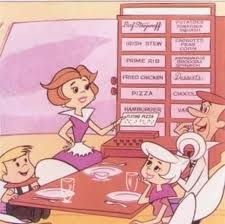 Even technology such as pop-up alarm beds and instant redecorating living rooms couldn’t erase the central problem of the human element. George Jetson hated to get up; he was lazy. He hated to go to work; his boss was a jerk. He hated to let his wife spend money on a new wardrobe; he was cheap. George was just a guy living the challenges of the timeless human condition; push button technology just made the condition work a little faster.
Even technology such as pop-up alarm beds and instant redecorating living rooms couldn’t erase the central problem of the human element. George Jetson hated to get up; he was lazy. He hated to go to work; his boss was a jerk. He hated to let his wife spend money on a new wardrobe; he was cheap. George was just a guy living the challenges of the timeless human condition; push button technology just made the condition work a little faster.
The Jetsons was a cartoon series from Hanna-Barbera that ran in primetime in 1962-63, and then continued in reruns, forever trapped in a futurist past of mechanistic space tech and swinging Kandinsky backgrounds.
There was a second series of The Jetsons in 1985-87. It is a pale, inferior copy of the original. But still, it offers us a vital lesson about creeping dystopia of the mind. The Jetsons of the 1980s pretends to be the same show. Same George, same boy Elroy, same daughter Judy, same Jane his wife. Same Astro and same Mr. Spacely. Same city. Same highrise apartment. Same flying cars and moving sidewalks. Okay, there was a new family pet named Orbitty who had all the charm and function of Cousin Oliver from The Brady Bunch, but he didn’t change anything.
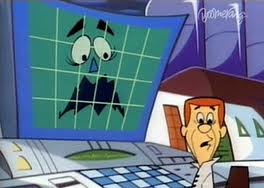
Still, there is something deep and sinister troubling the heart of the 1980s Jetsons. It isn’t the same at all. Future technology is no longer a charming background element in a basic sitcom plot. Machines are complex, even cunning. Technology is as likely to harm as help. The cheerful push button future is gone.
In the 1980s, the show has an underlying pessimism. No matter how hard George tries, he can only get so far because life is just too complicated; there are too many things that could go wrong. He can never escape his boring job at Spacely Sprockets, not because he is lazy, but because technology is beyond his or anyone else’s control. George is no longer living in a swinging Jetsonian world; he is trapped in a brutal Orwellian, Huxleyian, and the-guy-who-made-Metropolisian world.
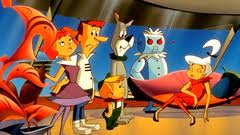
The Jetsons of the 1980s isn’t just a crappy cartoon, it is a crappy dystopian product of a society grown distrustful. No longer do machines make things easy for George; now they served to isolate his half-assed human efforts from social consequence. This isn’t, however, a conscious idea of the writers (that might’ve been entertaining, something the 1980s Jetsons cannot be accused of). Rather the dystopia is a reflection of the times.
In the decades between the early 1960s and the late 1980s, American society had become more cynical and distrustful for many reasons, among them the lingering feelings over Watergate, Vietnam, and a sullen leftwing backlash to the swaggering Reagan Era mentality. The relationship between technology and society had also changed. The 1980s was the dawn of the personal computer revolution, when computers were no longer just gigantic spinning wheels in vast government warrooms; they were now home appliances. Technological developments were happening in your living room, forcing you to learn BASIC whether you wanted to or not, and then becoming obsolete before you finished reading the manual.
By the 1980s, the very essence of the original Jetsons was no longer a universally accepted part of the social discourse. It had become impossible to view technological advancement with an optimistic and cheerful, if slightly confused, acceptance of the 1960s.
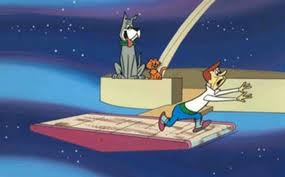
And like all great literature, it says more about us than about George.
This new George Jetson, it seems, will be forever trapped on the automatic dogwalk during the closing credits of the post-modern era. And even Jane can’t stop that crazy thing….
Clay and Susan Griffith are the authors ofThe Greyfriar: Vampire Empire Book 1 (Pyr Books). The second book in the Vampire Empire trilogy will be published September 2011. They are a married couple who have written and published together for more than a decade. Their credits not only include several books, but also numerous short stories published in many anthologies, some featuring noted genre characters like Kolchak the Night Stalker and The Phantom. They’ve also written for television and published graphic novels featuring characters such as The Tick and Allan Quatermain.










